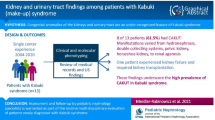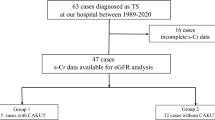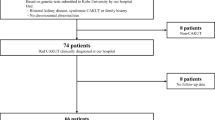Abstract
Beckwith–Wiedemann syndrome (BWS), an overgrowth disorder with several congenital abnormalities, encompasses nephrourological anomalies. The objective of the report is to analyze the latter and related genotype–phenotype correlations. The study was a retrospective review of nephrourological investigations and genotype in 67 BWS patients. Imaging and laboratory studies have been correlated with the molecular anomalies typical of BWS. Thirty-eight (56.7%) patients had a total of 61 nonmalignant nephrourological findings, including nephromegaly (n = 24), collecting system abnormalities (n = 14), cryptorchidism (n = 11), nephrolithiasis (n = 5), cysts (n = 5), and dysplasia (n = 1). Four patients had Wilms’ tumor, all associated with renal hyperplasia. Renal findings were almost consistent in the BWSIC1 group, with nephromegaly in all patients and collecting system abnormalities in half of them. BWSUPD and negative patients also had frequent anomalies (63.6% and 61.9% respectively), whereas only 36.0% of BWSIC2 had renal findings (p = 0.003). Cryptorchidism was associated with abdominal wall defects (p < 0.001) appearing more frequently in BWSIC2 (p = 0.028). Urinary tract infections were observed in 17.9% of patients, with two resulting in life-threatening sepsis. Hypercalciuria was present in 10% of cases. 55.5% of BWS patients have renal findings. Although variegate, these anomalies disclose a genotype–phenotype correlation.


Similar content being viewed by others
Abbreviations
- BWS:
-
Beckwith–Wiedemann syndrome
- GOM:
-
Gain of methylation
- IC:
-
Imprinting center
- IGF2:
-
Insulin growth factor 2
- LOM:
-
Loss of methylation
- UPD:
-
Uniparental disomy
- WT:
-
Wilms’ tumor
References
Choufani S, Shuman C, Weksberg R (2010) Beckwith-Wiedemann syndrome. Am J Med Genet Semin Med Genet C 154:343–354
Cooper WN, Luharia A, Evans GA, Raza H, Haire AC, Grundy R, Bowdin SC, Riccio A, Sebastio G, Bliek J, Schofield PN, Reik W, Macdonald F, Maher ER (2005) Molecular subtypes and phenotypic expression of Beckwith-Wiedemann syndrome. Eur J Hum Genet 13:1025–1032
Shuman C, Smith AC, Weksberg R (1993–2000) Beckwith-Wiedemann Syndrome. In: Pagon RA, Bird TC, Dolan CR, Stephens K (eds) GeneReviews. University of Washington, Seattle, WA (freely available at GeneReviews: http://www.ncbi.nlm.nih.gov/books/NBK1394/)
Bliek J, Gicquel C, Maas S, Gaston V, Le Bouc Y, Mannens M (2004) Epigenotyping as a tool for the prediction of tumor risk and tumor type in patients with Beckwith-Wiedemann syndrome (BWS). J Pediatr 145:796–799
DeBaun MR, Siegel MJ, Choyke PL (1998) Nephromegaly in infancy and early childhood: a risk factor for Wilms tumor in Beckwith-Wiedemann syndrome. J Pediatr 132:401–404
Rump P, Zeegers MP, van Essen AJ (1994) Tumor risk in Beckwith-Wiedemann syndrome: a review and meta-analysis. Am J Med Genet A 136:95–104
Scott RH, Walker L, Olsen ØE, Levitt G, Kenney I, Maher E, Owens CM, Pritchard-Jones K, Craft A, Rahman N (2006) Surveillance for Wilms tumor in at-risk children: pragmatic recommendations for best practice. Arch Dis Child 91:995–999
Elliott M, Maher ER (1994) Beckwith-Wiedemann syndrome. J Med Genet 31:560–564
DeBaun MR, Tucker MA (1998) Risk of cancer during the first four years of life in children from The Beckwith-Wiedemann Syndrome Registry. J Pediatr 132:398–400
Borer JG, Kaefer M, Barnewolt CE, Elias ER, Hobbs N, Retik AB, Peters CA (1999) Renal findings on radiological followup of patients with Beckwith-Wiedemann syndrome. J Urol 161:235–239
McNeil DE, Langer JC, Choyke P, DeBaun MR (2002) Feasibility of partial nephrectomy for Wilms’ tumor in children with Beckwith-Wiedemann syndrome who have been screened with abdominal ultrasonography. J Pediatr Surg 37:57–60
Choyke PL, Siegel MJ, Oz O, Sotelo-Avila C, DeBaun MR (1998) Non malignant renal disease in pediatric patients with Beckwith-Wiedemann syndrome. AJR Am J Roentgenol 171:733–737
Goldman M, Shuman C, Weksberg R, Rosenblum ND (2003) Hypercalciuria in Beckwith-Wiedemann syndrome. J Pediatr 142:206–208
Goldman M, Smith A, Shuman C, Caluseriu O, Wei C, Steele L, Ray P, Sadowski P, Squire J, Weksberg R, Rosenblum ND (2002) Renal abnormalities in Beckwith-Wiedemann syndrome are associated with 11p15.5 uniparental disomy. J Am Soc Nephrol 13:2077–2084
Wong CA, Cuda S, Kirsch A (2011) A review of the urologic manifestations of Beckwith-Wiedemann syndrome. J Pediatr Urol 7:140–144
Ortiz-Neira CL, Traubici J, Alan D, Moineddin R, Shuman C, Weksberg R, Epelman M (2009) Sonographic assessment of renal growth in patients with Beckwith-Wiedemann syndrome: the Beckwith-Wiedemann syndrome renal nomogram. Clinics (Sao Paulo) 64:41–44
Priolo M, Sparago A, Mammì C, Cerrato F, Laganà C, Riccio A (2008) MS-MLPA is a specific and sensitive technique for detecting all chromosome 11p15.5 imprinting defects of BWS and SRS in a single-tube experiment. Eur J Hum Genet 16:565–571
Romanelli V, Belinchón A, Benito-Sanz S, Martínez-Glez V, Gracia-Bouthelier R, Heath KE, Campos-Barros A, García-Miñaur S, Fernandez L, Meneses H, López-Siguero JP, Guillén-Navarro E, Gómez-Puertas P, Wesselink JJ, Mercado G, Esteban-Marfil V, Palomo R, Mena R, Sánchez A, Del Campo M, Lapunzina P (2010) CDKN1C (p57(Kip2)) analysis in Beckwith-Wiedemann syndrome (BWS) patients: genotype-phenotype correlations, novel mutations, and polymorphisms. Am J Med Genet A 152:1390–1397
Weksberg R, Shuman C, Beckwith JB (2010) Beckwith-Wiedemann syndrome. Eur J Hum Genet 18:8–14
Rosenbaum DM, Korngold E, Teele RL (1984) Sonographic assessment of renal length in normal children. AJR Am J Roentgenol 142:467–469
Sparago A, Cerrato F, Vernucci M, Ferrero GB, Silengo MC, Riccio A (2004) Microdeletions in the human H19 DMR result in loss of IGF2 imprinting and Beckwith-Wiedemann syndrome. Nat Genet 36:958–960
Shah K (1983) Beckwith-Wiedemann syndrome: role of ultrasound in its management. Clin Radiol 34:313–319
Pettenati MJ, Haines JL, Higgins RR, Wappner RS, Palmer CG, Weaver DD (1986) Wiedemann-Beckwith syndrome: presentation of clinical and cytogenetic data on 22 new cases and review of the literature. Hum Genet 74:143–154
Elliott M, Bayly R, Cole T, Temple IK, Maher ER (1994) Clinical features and natural history of Beckwith-Wiedemann syndrome: presentation of 74 new cases. Clin Genet 46:168–174
Hunter AG, Allanson JE (1994) Follow-up study of patients with Wiedemann-Beckwith syndrome with emphasis on the change in facial appearance over time. Am J Med Genet 51:102–107
Moore ES, Ward RE, Escobar LF, Carlin ME (2000) Heterogeneity in Wiedemann-Beckwith syndrome: anthropometric evidence. Am J Med Genet 90:283–290
Beckwith JB, Kiviat NB, Bonadio JF (1990) Nephrogenic rests, nephroblastomatosis and the pathogenesis of Wilms’ tumor. Pediatr Pathol 10:1–36
Russo S, Finelli P, Recalcati MP, Ferraiuolo S, Cogliati F, Dalla Bernardina B, Tibiletti MG, Agosti M, Sala M, Bonati MT, Larizza L (2006) Molecular and genomic characterization of cryptic chromosomal alterations leading to paternal duplication of the 11p15.5 Beckwith-Wiedemann region. J Med Genet 43:3929
Kulkarni R, Wolf JS Jr, Padiyar N, Zuckerman L, Gera R, Scott-Emuakpor AB (2002) Severe intrarenal fibrosis, infundibular stenosis, renal cysts, and persistent perilobar nephrogenic rests in a patient with Beckwith-Wiedemann syndrome 27 years after diffuse nephroblastomatosis and Wilms tumor: natural progression or a consequence of treatment? J Pediatr Hematol Oncol 24:389–393
Acknowledgement
This work was supported by funding from the grants MIUR (Italian Ministry for Education, University and Research) PRIN 2007 (to AR) and ISS526D/35 (to LL). The authors declare that they have no conflict of interest with respect to this article. GBF had full access to all the data in the study and takes responsibility for the integrity of the data and the accuracy of the data analysis.
Financial disclosure declaration
The authors declare they have no conflict of interest with respect to this article.
Author information
Authors and Affiliations
Corresponding author
Additional information
Ethical approval
As a rule, no approval is required at our Institutions for retrospective studies involving the anonymous review of medical records
Rights and permissions
About this article
Cite this article
Mussa, A., Peruzzi, L., Chiesa, N. et al. Nephrological findings and genotype–phenotype correlation in Beckwith–Wiedemann syndrome. Pediatr Nephrol 27, 397–406 (2012). https://doi.org/10.1007/s00467-011-2009-4
Received:
Revised:
Accepted:
Published:
Issue Date:
DOI: https://doi.org/10.1007/s00467-011-2009-4




